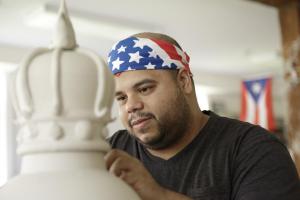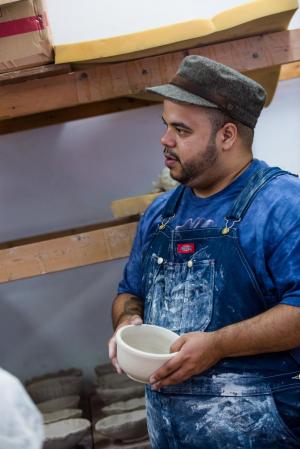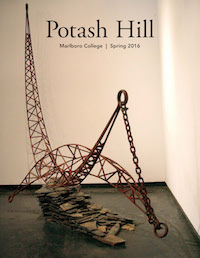 “The sort of questions that Marlboro students ask are aligned with the questions that I ask,” says Roberto Lugo, who joined Marlboro as the ceramics professor last fall. “People here just have a tendency to question everything, which is really refreshing. I would get bored just teaching people how to be technically virtuous potters. I’m more interested in how pottery relates to biology, how pottery relates to anthropology, and all these other ways that people here really question.”
“The sort of questions that Marlboro students ask are aligned with the questions that I ask,” says Roberto Lugo, who joined Marlboro as the ceramics professor last fall. “People here just have a tendency to question everything, which is really refreshing. I would get bored just teaching people how to be technically virtuous potters. I’m more interested in how pottery relates to biology, how pottery relates to anthropology, and all these other ways that people here really question.”
Rob didn’t always know he would be a ceramic artist. Growing up in West Philadelphia, he had a flair for painting graffiti art on abandoned buildings, but he recognized that the only way to be economically successful in that environment was selling drugs. When he realized that too many among his family and friends had suffered from violence or imprisonment due to their involvement in the drug trade, he left the city to live with a cousin in Florida. He started ceramics at a community college there, at the age of 25, and has never looked back. He received his bachelor’s in ceramics from Kansas City Art Institute and an MFA from Pennsylvania State University.
Marlboro is very different from the academic environments Rob had experienced in the past, not to mention the most rural environment in which he has found himself (he relished eating his first apple straight from a tree this fall, for example). What drew him to the college, as is the case for many faculty, was the close-knit community and students’ sense of engagement in their own self-designed course of study.
“I liked that Marlboro has a curriculum that sort of creates itself based on the interests of the students,” says Rob. “I knew if I wanted to walk on new terrain, and think about ways that clay hasn’t been used before, I would really have to be grounded by people who are doing similar things with their own interests. Since I got here I feel like I’m discovering something new every day.”
Rob sees ceramics classes as a unique environment for bringing people together as a community. His introductory class last fall included everyone from freshmen to local community members, including retired economics professor Jim Tober, and he liked creating an environment in which they could learn from each other. He’s found Marlboro to be unique, in his experience, in the level of openness and encouragement that students share with each other.
 “With artwork, the conversation will be around communicating your idea rather than whether your idea is valid or not,” he says. “That’s what I like about it, because a person is welcome to express themself in whatever way they wish, and our jobs, as we critique the work, is to let that person know whether they are doing it effectively.”
“With artwork, the conversation will be around communicating your idea rather than whether your idea is valid or not,” he says. “That’s what I like about it, because a person is welcome to express themself in whatever way they wish, and our jobs, as we critique the work, is to let that person know whether they are doing it effectively.”
Rob’s own work juxtaposes images from popular culture, European decorative patterning, and rich symbolism drawn from his Puerto Rican heritage, creating a hybrid of visual arts traditions that stimulates new conversations surrounding cultural tolerance. His designs have ranged from combining graffiti and fine china to putting Nobel Prize laureate and Pakistani activist Malala Yousafzai and cartoon character Fat Albert on the same pot.
“It kind of gets people questioning what they hold dear about design,” says Rob. “Are you attached to the aristocratic component of it? Or are you willing to see where both of our needs, and both of our ideas, intersect? I like challenging people in that way.”
Rob believes that his physical work gains strength from his other work as an activist, doing public speaking and making videos that address poverty, prejudice, and injustice. In one video, he returned to Philadelphia, to a block of burned-out houses with “stairways going to nowhere,” where he assembled a pottery wheel out of discarded objects and threw a pot from clay reclaimed on site. His impassioned speech at the 2015 NCECA (National Council on Education for the Ceramic Arts) conference, where he was presented with an emerging artist award, has gained him national recognition.
“I think that sort of multimodal practice really lends itself to the Marlboro community,” Rob says. He is collaborating with economics professor John Rush on a project in Puerto Rico, where faculty and students will help introduce a sustainable pottery workshop to bring revenue to a disadvantaged community. He looks forward to collaborating with other professors as well, in areas of study from anthropology to performance art. One thing that remains to be seen is how Rob’s art will change from his experiences at Marlboro.
“My work has a close relationship with my experience as a human, and has always included a discussion of what it means to be a person of color from a really poor neighborhood,” says Rob. “Now I’m a professor, and I’m in Vermont, so what does that mean for my work? Am I going to draw a moose on my pots? Because I think that would actually look really cool.”

